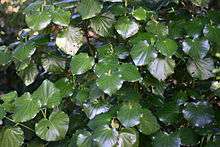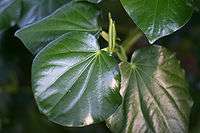Macropiper excelsum
| Kawakawa | |
|---|---|
 | |
| Scientific classification | |
| Kingdom: | Plantae |
| (unranked): | Angiosperms |
| (unranked): | Magnoliids |
| Order: | Piperales |
| Family: | Piperaceae |
| Genus: | Piper |
| Species: | P. excelsum |
| Binomial name | |
| Piper excelsum (G.Forst.) Miq. | |
Piper excelsum (formerly known as Macropiper excelsum), called Kawakawa, is a small tree of which the subspecies M. excelsum subsp. excelsum is endemic to New Zealand; the subspecies M. e. subsp. psittacorum is found on Lord Howe Island, Norfolk Island and the Kermadec Islands
Description
It is found throughout the North Island, and as far south as Okarito (43.20 °S) on the West Coast and Banks Peninsula (43.5 °S) on the east coast of the South Island. The leaves are often covered with insect holes. The images depict the variety majus which has larger and more glossy leaves than P. excelsum. The name Kawakawa in Māori refers to the bitter taste of the leaves, from kawa bitter.[1]
Leaves
The Kawakawa leaves are about 5–10 cm long by 6–12 cm wide; they are opposite to each other, broadly rounded with a short drawn-out tip and are heart-shaped at their bases. The leaves are deep green in color if growing in the forest but may be yellowish-green when growing in more open situations.
Flowers
The flowers are produced on greenish, erect spikes that are 2.5-7.5 cm long. Kawakawa flowers are quite minute and very closely placed around the spike. After pollination the flowers gradually swell and become fleshy to form small, berry-like fruits that are yellow to bright orange.
Berries
Each berry cluster is the size of a small finger . Ripening period is January and February. These fruits are favoured by kereru, or New Zealand pigeon (Hemiphaga novaeseelandiae) and tui (Prosthemadera novaeseelandiae).
Uses
The leaves of kawakawa are used to make Kawakawa ointment, which is a natural anti-bacterial and anti-inflammatory.[2] Titoki Liqueur, which is exported to Japan, Australia, Fiji and the United Kingdom. The seeds of this plant are employed as a culinary spice and they could be commercially used for that purpose, as this tree is related to Piper nigrum (black pepper) and it is grown as an ornamental plant.

Kawakawa is a traditional medicinal plant of the Māori. An infusion is made from the leaves or roots, and used for bladder problems, boils, bruises, to relieve pain or toothache, or as a general tonic. The sweet edible yellow berries (most often found in summer on female trees) of the plant were eaten as a diuretic. Host people of a marae wave leaves of kawakawa to welcome guests, especially at tangi. Both they and the guests may wear wreaths of kawakawa on the head as a sign of mourning.
Relationship with kava
Kawakawa is sometimes called "Maori kava" and is often confused with the Kava plant (piper methysticum). While the two plants look similar and have similar names, they are different, albeit related, species. Kava is a traditional plant and beverage of the South Pacific. The roots of the plant are used to produce a drink with medicinal, sedative, anesthetic, euphoriant, and entheogenic properties.[3] It is most likely not a coincidence that this plant has a similar name to kawakawa. As noted by the Kava Society of New Zealand "in all likelihood the kava plant was known to the first settlers of Aotearoa [New Zealand]. It is also possible that (just like the Polynesian migrants that settled in Hawaii) the Maori explorers brought some kava with them. Unfortunately, most of New Zealand is simply too cold for growing kava and hence the Maori settlers lost their connection to the sacred plant."[4] According to Lebot et al (1997) "In New Zealand, where the climate is too cold for kava, the Maori gave the name kawa-kawa to another Piperaceae, M. excelsum, in memory of the kava plants they undoubtedly brought with them and unsuccessfully attempted to cultivate. The Maori word kawa also means "ceremonial protocol", recalling the stylized consumption of the drug typical of Polynesian societies"[3]
See also
Notes
- ↑ It has also been surmised that when Māori first came to New Zealand, they named the plant 'Kawakawa' because they recognised that the plant was a close relative of Piper methysticum, the plant from which kava is made in the tropical Pacific. However, given that Piper species also occur in tropical Polynesia, it is more likely they simply applied the name of those plants to the New Zealand variety. In the Cook Islands and the Marquesas for instance, P.latifolium is known as 'Kavakava-atua'; in Samoa it is called 'Ava'ava-aitu'. P. latifolium is very similar in appearance to the New Zealand species, and is also used in traditional medicine in the Cook Islands.
- ↑ http://www.kawakawaremedies.co.nz/#!kawakawa-science/c12wr
- 1 2 Lebot, Vincent; Merlin, Mark; Lindstrom, Lamont (1997-02-01). Kava: The Pacific Elixir: The Definitive Guide to Its Ethnobotany, History, and Chemistry. Inner Traditions / Bear & Co. ISBN 9780892817269.
- ↑ "Kava vs Kawakawa | Kava use in New Zealand | Maori Memories of Kava". kavasociety.nz. Retrieved 2016-07-11.
References
- Bone, K. "A clinical guide to blending liquid herbs". St. Louis, MO, Churchill Livingstone, 2003.
- Brooker S.G., R.C. Cambie & R.C. Cooper, New Zealand Medicinal Plants. Heinemann, Auckland, 1981.
- Metcalf, L. "Know your New Zealand Plants". New Holland Publishers (NZ) Ltd, Auckland, 2009.
External links
| Wikimedia Commons has media related to Macropiper excelsum. |
- Cook Islands Biodiversity Database
- Landcare Research plant database
- Plants in New Zealand Poisonous to Children
- The Encyclopedia of Alternative & Natural Medicine